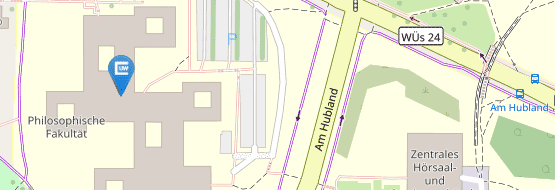Press
See also einBLICK 24.10.2023
Irish Studies begrüßen Gastprofessorin
Prof. Dr. Maureen O’Connor erforscht die weibliche Perspektive oder die Rolle von Tieren in der irischen Literatur des 19. und 20. Jahrhunderts. Im neuen Wintersemester teilt sie ihr Wissen als Gastprofessorin an der Uni Würzburg.
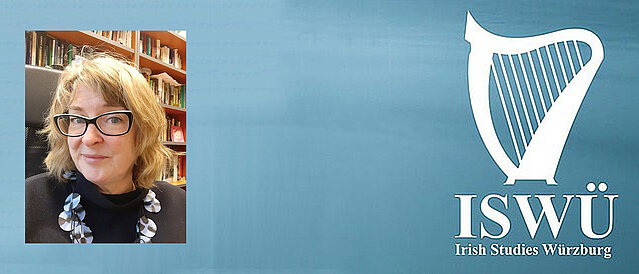
Maureen O’Connor freut sich auf eine spannende und lehrreiche Zeit in Würzburg. (Bild: privat / ISWÜ)
Die Irish Studies Würzburg (ISWÜ) freuen sich, Maureen O'Connor vom irischen University College Cork als Gastprofessorin im Wintersemester 2023/24 an der Julius-Maximilians-Universität Würzburg (JMU) begrüßen zu dürfen. Möglich macht das die Finanzierung durch das Emigrant Support Programme (ESP) der irischen Botschaft in Berlin. Weitere Unterstützung für die Unterbringung stellt das Siebold-Collegium Institute for Advanced Studies Würzburg (SCIAS) bereit.
Der Kontakt nach Würzburg war 2021 entstanden, als Maureen O’Connor einen Vortrag zu einem Online-Workshop an der JMU beisteuerte. Trotz des rein digitalen Formats empfand sie die Erfahrung schon damals als „anregend und gesellig“ und „hoffte, bald die Gelegenheit zu haben, die Universität persönlich zu besuchen.“
Eintauchen in Kultur und Bildungssystem
Diese Chance ergibt sich nun in Form der Stelle als Gastprofessorin. Darüber zeigt sich die Literaturwissenschaftlerin hocherfreut. „Ich konnte mein Glück kaum fassen“ beschreibt O’Connor ihre Gefühlslage nach der Zusage aus Würzburg. Vergangene Aufenthalte an ausländischen Universitäten wären rein auf die Forschung beschränkt und kürzer gewesen. Jetzt reize sie besonders „die Aussicht auf ein umfassendes Eintauchen in eine andere Kultur sowie in ein anderes Bildungssystem und ein mir unbekanntes Institut.“
Gerade auf die anstehenden Lehrveranstaltungen blickt Maureen O’Connor mit viel Vorfreude. Einen herzlichen Empfang erlebte sie bereits bei einem Symposium für Doktorandinnen und Doktoranden der Environmental Humanities: „Die Studierenden hier in Würzburg sind eindeutig eine außergewöhnliche Gruppe, und ich freue mich darauf, von ihnen zu lernen“, so die Gastprofessorin. Speziell die Herausforderung, ihr bisher noch unbekannte Texte mit den Studierenden zu erarbeiten und zu diskutieren, sei vielversprechend.
Neben neuer fachlicher Erkenntnisse erhofft sich Maureen O’Connor vor allem, „zumindest ein bisschen Deutsch zu lernen.“
Abwechslungsreiches Programm
Im Rahmen ihres Aufenthalts wird Maureen O'Connor drei Kurse unterrichten: “The Comic Tradition in Irish Writing “, “Irish Women's Writing at the Fin de Siècle” und “The Natural World in Irish Women's Writing”.
Außerdem wird sie am Donnerstag, 30. November, einen Vortrag zum Thema "Haunted Nature in the Fiction of Edna O'Brien" halten.
Zusätzlich organisiert Maureen O’Connor gemeinsam mit den Professorinnen Ina Bergmann, Maria Eisenmann und Kirsten Sandrock von ISWÜ vom 21. bis 23. Februar 2024 ein internationales und interdisziplinäres Symposium zum Thema "The Animal in Ireland, Real and Imagined" an der JMU.
Zur Person
Maureen O'Connor ist Senior Lecturer in der Abteilung für Englisch am University College Cork in Irland. Sie hat zahlreiche Publikationen auf dem Gebiet der Irish Studies veröffentlicht und Grundsatzvorträge in Indien, Japan, Österreich, Spanien und Frankreich gehalten. Sie ist die Autorin von The Female and the Species: The Animal in Irish Women's Writing (2010). Weiterhin ist sie Mitherausgeberin einer Reihe prägender Bände ihres Forschungsbereichs.
Ihr neuestes Buch, Edna O'Brien and the Art of Fiction, das 2021 bei Bucknell University Press erschienen ist, wurde von der Schriftstellerin Éilís Ní Dhuibhne als "ein wunderbares Buch, unverzichtbar für jeden, der sich für Edna O'Brien oder die zeitgenössische irische Literatur interessiert" beschrieben. Derzeit schreibt O'Connor an einem Band für die Reihe der Cork University Press, Síreacht: Longings for Another Ireland, zum Thema Tiere.
Kontakt
Prof. Dr. Ina Bergmann, ina.bergmann@uni-wuerzburg.de
Prof. Dr. Maria Eisenmann, maria.eisenmann@uni-wuerzburg.de
Prof. Dr. Maureen O’Connor, maureen.oconnor@uni-wuerzburg.de
Artikel von Lutz Ziegler
See also einBLICK 22.11.2022
Marisa Ammersbach studiert in Würzburg Political and Social Studies mit Englisch im Nebenfach. Im Sommer absolvierte sie ein Praktikum am irischen University College Cork. Dabei arbeitete sie an einem über 380 Jahre alten Text.
Das Corpus of Electronic Texts, kurz CELT, ist die größte digitale Sammlung für Texte mit Bezug zu Irland. Beheimatet ist CELT am University College Cork (UCC) im Süden der Grünen Insel. Dort absolvierte Marisa im Juli und August 2022 ein Praktikum. Ihre Aufgabe: Einen frühneuhochdeutschen Text in ein modernes Schriftbild übertragen.
Marisa, die kurz vor ihrem Bachelor-Abschluss steht, war die erste Studierende der Julius-Maximilians-Universität (JMU) Würzburg, die die Möglichkeit für ein Praktikum bei CELT genutzt hat.
„Ich hatte gar nicht auf dem Schirm, dass man sowas beruflich machen kann“, erzählt sie und ergänzt, dass ihr „solche Textarbeit schon immer Spaß gemacht“ hat. Beim bearbeiteten Text handelte es sich um Erzählungen eines Militärkaplans, der während des 30-jährigen Krieges einen hochrangigen irischen Militär auf dem europäischen Kontinent begleitet hatte.
Auslandssemester light
Marisa hatte Ende 2021 durch eine E-Mail des Fachbereichs Anglistik & Amerikanistik von dem Praktikumsangebot erfahren und sich auch deshalb beworben, weil sie aufgrund von Corona ein geplantes Auslandssemester nicht antreten konnte: „Eigentlich hatte ich eine Zusage für Genua mit Erasmus+, aber daraus wurde dann leider nichts.“
Auch wenn das knapp dreiwöchige Praktikum kein Ersatz für ein ganzes Auslandssemester war, genoss Marisa ihre Zeit in Irland: „An den Wochenenden habe ich Ausflüge gemacht und zum Schluss noch einige Tage in Dublin verbracht. Es ist ein tolles Land mit sehr lieben und hilfsbereiten Menschen. Das war besonders schön, weil ich allein unterwegs war.“
Bei CELT arbeitete Marisa eng mit ihrer Supervisorin Beatrix Färber zusammen: „Das hat perfekt geklappt. Die Arbeit mit einem alten Text war für mich neu. Beatrix hat mir viel Freiheiten gelassen, war bei Fragen aber immer für mich da.“
Die Arbeit bei CELT
Auch Beatrix Färber war mit der Arbeit ihrer Praktikantin sehr zufrieden: „Marisa hat das wirklich gut gemacht. Ihr Text hatte fast 340 Seiten, alles in Fraktur gedruckt und in einer ungewohnten Sprache. Sie hat etwa die Hälfte geschafft, das ist sehr beachtlich.“
Der Text kam aus dem Münchner Digitalisierungszentrum der Bayerischen Staatsbibliothek, wo er abgescannt wurde. Da die Software allerdings nicht in der Lage ist, ihn komplett anzupassen, muss er von Hand redigiert und in ein modernes Schriftbild gebracht werden.
„Mögliche nächste Schritte wären dann eine Übersetzung in modernes Deutsch oder ins Englische“, erklärt Beatrix Färber.
Zusammenarbeit mit den Irish Studies Würzburg
Angeboten wird das Praktikum am CELT von den Irish Studies Würzburg (ISWÜ) der JMU. Professorin Maria Eisenmann, gemeinsam mit Professorin Ina Bergmann Initiatorin von ISWÜ, zeigt sich sehr erfreut über den geglückten Start dieser Kooperation: „Die Idee für das Praktikum entstand über den wissenschaftlichen Austausch mit Beatrix und anderen Historikern des UCC. Wir waren noch auf der Suche nach weiteren Angeboten für Studierende und fanden eine Kooperation mit CELT sehr gewinnbringend. Zusammen haben wir bereits verschiedene Veranstaltungen wie Gastvorträge, einen Studientag und ein Symposium realisiert. In Zukunft möchten wir diesen Kontakt noch ausbauen, wir streben zum Beispiel auch eine Erasmus-Kooperation an“, erklärt Eisenmann.
Informationen zum Praktikum finden sich auf der Seite von ISWÜ. Bewerbungen für Praktikumsplätze im Sommer 2023 sind noch bis zum 31. Januar 2023 möglich. Bewerben können sich alle Studierenden des Fachbereichs Anglistik & Amerikanistik.
Marisa jedenfalls kann das Praktikum „definitiv weiterempfehlen.“ Für sie war Irland eine durchweg positive Erfahrung.
Links
Weitere Informationen zu Internships der Irish Studies Würzburg
Zur digitalen Sammlung Corpus of Electronic Texts (CELT)
See also einBlick 21.06.2022
Mit der Geschichte Irlands und den Herausforderungen, vor denen das Land heute steht, befasst sich ein öffentliches Symposium in englischer Sprache. Dazu laden die Irish Studies Würzburg am 1. Juli 2022 ein.
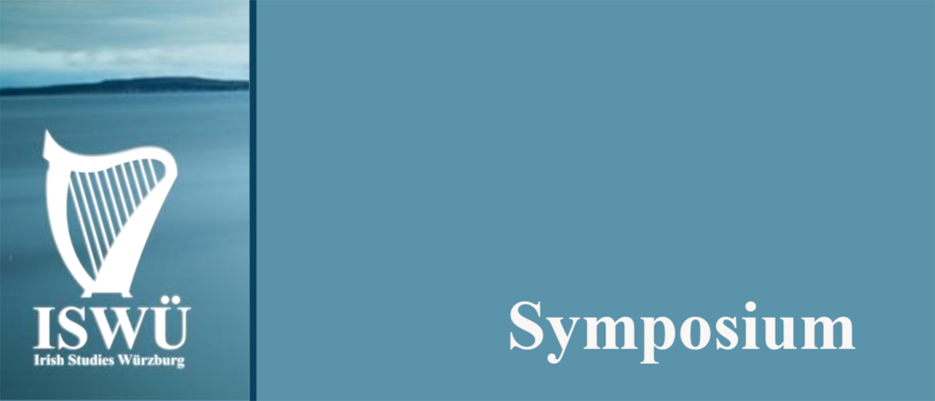
Klimakrise, Digitalisierung, Corona-Pandemie, Totalitarismus, Rassismus und Sexismus: Das sind nur einige der Herausforderungen, vor denen die Gesellschaften der Welt im 21. Jahrhundert stehen. Irland und Nordirland sowie die Irinnen und Iren, die in anderen Ländern leben, müssen sich mitsamt ihren Partnern in Europa auch noch mit den Auswirkungen des Brexit auseinandersetzen.
Für die irische Insel sind die Folgen des Brexit politisch besonders brisant. Welche Strategien können helfen, die mit dem Brexit verbundenen europäischen und transatlantischen Herausforderungen zu meistern? Kann ein Blick zurück in die Geschichte Irlands Orientierung bieten und Ideen für die Gestaltung der Gegenwart liefern? Kann die jüngere Generation, ausgestattet mit dem Wissen über die Vergangenheit, eine bessere Zukunft gestalten?
Beteiligt sind Universitäten aus Irland, Belgien und Deutschland
Hier setzt das Symposium "History in Stories: The Irish Past and the Challenges of the Present" an: Sein Ziel ist es, Texte aus der irischen Vergangenheit sowie Texte über die irische Geschichte daraufhin zu untersuchen, ob sich aus ihnen Lehren ziehen lassen. Betrachtet werden sowohl fiktionale Texte als auch historische Dokumente.
Wissenschaftlerinnen und Wissenschaftler aus Literaturwissenschaft, Geschichte und Fachdidaktik (TEFL) werden sich der irischen „Geschichte in Geschichten“ nähern. Sie kommen vom University College Cork (Irland), vom Centre for Irish Studies der Katholischen Universität Leuven (Belgien) und von den Irish Studies der Universität Würzburg. Die drei Universitäten kooperieren bereits in Forschung und Lehre auf dem Gebiet der Irish Studies und wollen ihre Zusammenarbeit mit dem Symposium festigen und weiter ausbauen.
Organisiert wird das Symposium vom Team der Irish Studies Würzburg um die Professorinnen Ina Bergmann und Maria Eisenmann, beide vom Institut für Anglistik und Amerikanistik. Gefördert wird es von der Fritz Thyssen Stiftung, der irischen Botschaft und dem Universitätsbund Würzburg. Die Vorträge und Diskussionen laufen am Freitag, 1. Juli 2022, von 9:00 bis 18:30 Uhr in englischer Sprache.
Das Symposium findet als hybride Veranstaltung statt. Interessierte, die nicht aktiv als Vortragende oder Moderierende beteiligt sind, können online teilnehmen. Wer online teilnehmen möchte, kann sich bis 28. Juni 2022 mit einer E-Mail an irishstudies@uni-wuerzburg.de anmelden.
Weblinks
Symposium "History in Stories: The Irish Past and the Challenges of the Present".
See also einBLICK 13.04.2021
Zwei Professorinnen der Uni setzen mit Irland einen neuen interfakultären Schwerpunkt. Die Auftaktveranstaltung der „Irish Studies Würzburg“ findet am 16. April 2021 um 16:30 Uhr statt. Sie steht auch Nicht-Akademikern offen.
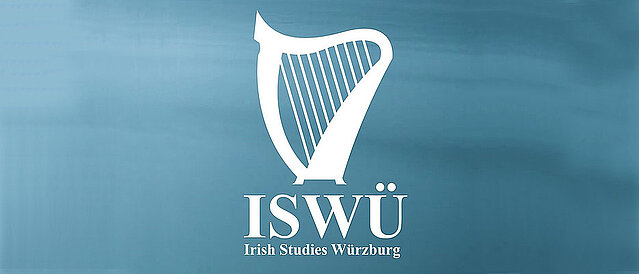
Logo der „Irish Studies Würzburg“. Die Auftaktveranstaltung findet am 16. April 2021 statt. (Bild: Universität Würzburg)
Der Brexit wird extreme Auswirkungen auf Irland haben. Die Ausschreitungen der letzten Tage in Belfast haben dies deutlich gezeigt. Welche Konsequenzen sie befürchten, davon berichten die nordirischen Autorinnen Colette Bryce und Jan Carson am 16. April beim Kick-off Event der „Irish Studies Würzburg“ (ISWÜ). Mit der virtuellen Veranstaltung wird das neu gegründete interfakultäre Forum ISWÜ an der Julius-Maximilians-Universität (JMU) Würzburg offiziell eröffnet. Eingerichtet wurde es bereits im vergangenen Sommersemester von den Professorinnen Ina Bergmann und Maria Eisenmann.
Enge Verbindung zu Irland
Irland, seit 1922 ein unabhängiger Staat und seit 1973 Mitglied der Europäischen Union, hat hierzulande viele Fans. Vor über 60 Jahren weckte Heinrich Böll durch sein „Irisches Tagebuch“ die Sehnsucht nach der grünen Insel. Wenige Jahre später begannen „The Dubliners“ für Irland zu begeistern. Maria Eisenmann, Inhaberin des Lehrstuhls für Fachdidaktik – Moderne Fremdsprachen an der JMU, fing in den 1990er Jahren Feuer. „Damals reiste ich auf eigene Faust für mehrere Wochen mit dem Auto über die Insel“, erzählt die Professorin, die seit 2015 in Würzburg forscht und lehrt.
Ob man immer in seiner Heimat lebt oder migriert, ist ein wesentlicher Unterschied, der die eigene Identität prägt. Viele Iren, die seit der Industriellen Revolution nach Amerika ausgewandert sind, können davon berichten. „Die Bezüge zwischen den USA und Irland sind vielfältig und faszinierend“, sagt die Amerikanistin Ina Bergmann. Durch Kontakte zu irischen Hochschulen begann sie, sich immer intensiver für irisch-amerikanische Literatur, Kultur und Geschichte zu interessieren. Der Wunsch, intensiver zu forschen, erwachte. Durch die Zusammenarbeit mit Maria Eisenmann kam es schließlich zur Einrichtung der ISWÜ.
Kooperation mit der Universität Cork
Dass das Forum gerade am 16. April offiziell aus der Taufe gehoben wird, hat einen speziellen Anlass: An diesem Tag jährt sich der Geburtstag des irischen Dramatikers John Millington Synge, der eine Weile an der JMU in Würzburg studierte, zum 150. Mal. Bei der Auftaktveranstaltung wird Jochen Achilles, emeritierter Amerikanistik-Professor der JMU, darauf eingehen. Weiter wird er aufzeigen, inwieweit Irland und die Iren mit Europa und der Welt verbunden sind. Schließlich wird er die Entwicklungen in den European Irish Studies sowie die Internationalisierung des irischen Dramas aus deutscher Sicht beleuchten. Dr. Damian Bracken, Dozent am University College Cork referiert über St. Columbanus, der als einer der ersten Iren Einfluss auf Europas Geschichte hatte.
In den kommenden Semestern soll das Forum ISWÜ Zug um Zug ausgebaut werden. Bereits in diesem Sommersemester wird in der Reihe „WueGlobal“ ein virtuelles Konversationsseminar unter Beteiligung der Universität Cork stattfinden. Außerdem wird es Lehrveranstaltungen und Gastvorträge zu Irland geben. Zudem planen Bergmann und Eisenmann ein interdisziplinäres Symposium zu Irland, bei dem Literaturwissenschaftler, Fachdidaktiker und Historiker zu Wort kommen sollen. Künftig würden die beiden Forscherinnen auch gern Gastprofessoren einladen.
Öffnung auch für Nicht-Akademiker
Das Forum kommt letztlich allen Bürgern zugute, die auf der Suche nach Experten zum Thema „Irland“ sind. Eisenmann und Bergmann wollen mit den „Irish Studies Würzburg“ ausdrücklich auch nicht-akademischen Kreisen Möglichkeiten zur Zusammenarbeit und zum internationalen Dialog eröffnen. Interessierte Bürgerinnen und Bürger mit Irland-Passion, die am 16. April am Kick-off-Event via Zoom teilnehmen, lernen dabei unter anderem den irischen Botschafter, Dr. Nicholas O’Brien, und auch Professorin Katharina Rennhak kennen, Präsidentin der European Federation of Associations and Centres of Irish Studies (EFACIS). „Irish Studies Würzburg“ gehört seit seiner Einrichtung EFACIS an.
ISWÜ ist ein ambitioniertes Projekt, das hervorragend nach Würzburg passt – hat die Domstadt doch eine über 1300-jährige Verbindung nach Irland. Im 7. Jahrhundert kamen die irischen Wandermönche Kilian, Kolonat und Totnan nach Franken, um hier den christlichen Glauben zu verbreiten. Kilian ist bis heute der bekannteste von ihnen. An ihn erinnert zum einen der Kiliansdom, zum anderen das „Kiliani“ als das größte kirchliche und weltliche Fest in der Region. Wegen dieser vielfältigen Bezüge gilt Würzburg als „die irische Stadt auf dem Kontinent“. Würzburger Irland-Liebhaber schlossen sich 1986 zur Deutsch-Irischen Gesellschaft zusammen, die ebenfalls mit ISWÜ kooperiert.
Mehr als nur Klischees
Selbst Irlandfans besitzen jedoch oft nur rudimentäre Kenntnisse in Irlandistik. Stereotype prägen das Bild. Beim Stichwort „Irland“ fällt den meisten Menschen die Farbe Grün ein, andere denken als erstes an irische Pubs. Was dran ist an landläufigen Klischees, kann am 16. April mit den Autorinnen Colette Bryce und Jan Carson diskutiert werden. Colette Bryce, 1970 im nordirischen Derry geboren, wurde mit dem britischen Literaturpreis Cholmondeley Award ausgezeichnet. Die Belfasterin Jan Carson erhielt 2019 für ihren Roman „The Fire Starters“ den Literaturpreis der Europäischen Union.
Dass man in einem deutschen Buchladen auf die beiden Schriftstellerinnen stößt, ist eher unwahrscheinlich, dabei sind beide interessant und haben viel zu sagen. Davon zeugt zum Beispiel ein Gastbeitrag von Jan Carson im „Tagesspiegel“ vom Juni 2020. Unter der Überschrift „Im Königreich der Risse“ geht die Autorin auf die Corona-Pandemie und den Brexit ein. Sie quäle sich mit Zweifeln, was ihre Identität anbelangt, bekennt Carson, die einen britischen und einen irischen Pass besitzt, in ihrem Beitrag. „Bis vor kurzem war mir meine britische Identität sehr bewusst, aber in Belfast die täglichen Verlautbarungen aus Downing Street zu sehen, war eine zunehmend befremdliche Erfahrung“, schreibt sie wörtlich. Sie beschleiche allmählich der Verdacht, dass die Tory-Regierung „weder viel von Nordirland versteht, noch sich besonders dafür interessiert“
See also einBlick 23.06.2020
In der Universitätsbibliothek bekam der irische Botschafter Dr. Nicholas O'Brien historisches irisches Kulturgut präsentiert. Außerdem informierte er sich an der Uni über die neue Forschungskooperation „Irish Studies Würzburg“.
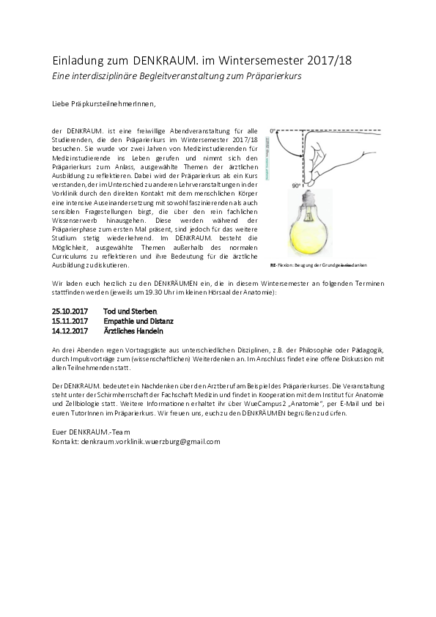
Besuch aus Irland in der Unibibliothek (von links): Christian Malzer, Leiter der Abteilung Handschriften und Alte Drucke, Universitätspräsident Alfred Forchel, der irische Botschafter Nicholas O’Brien, seine Partnerin Mary McCarthy und Hans-Günter Schmidt, Leiter der Universitätsbibliothek. (Bild: Irmgard Götz-Kenner / Universitätsbibliothek Würzburg)
Einige herausragende Zeugnisse der irischen Geschichte gehören zum Besitz der Universitätsbibliothek Würzburg. Kein Wunder also, dass Nicholas O’Brien, seit August 2019 Botschafter der Republik Irland in Berlin, bei einem erneuten Aufenthalt in Würzburg am 17. Juni 2020 auch die Universitätsbibliothek besuchte. Mit dabei war seine Partnerin Mary McCarthy.
Rund 1500 Handschriften aus dem Mittelalter und noch einmal 800 aus der Neuzeit befinden sich in der Handschriftenabteilung im dritten Stock der Universitätsbibliothek. Ein absolutes Prachtstück darunter ist das Kiliansevangeliar, eine Pergamenthandschrift aus dem 6. Jahrhundert. Ihr Vorderdeckel ist mit filigranen Schnitzereien aus Elfenbein verziert, in ihrem Inneren sind auf rund 300 Seiten die vier Evangelien des Neuen Testaments niedergeschrieben.
Die Legende zum Kiliansevangeliar
Das Kiliansevangeliar soll dem irischen Missionar Kilian gehört haben. Dieser brachte der Legende nach im Jahr 686 mit seinen Begleitern Kolonat und Totnan das Christentum nach Würzburg. Hier aber stießen die Mönche offenbar auf wenig Dankbarkeit, denn wenige Jahre später wurden sie ermordet. Ihre Leichen verscharrte man angeblich dort, wo heute das Neumünster steht. Als Würzburgs Bischof Burkhard im Jahr 752 Kilians Gebeine bergen ließ, soll im Grab das Kiliansevangeliar gefunden worden sein.
Diese Geschichte dürfte in der Tat nur eine Legende sein. Wahrscheinlicher ist es, dass das Kiliansevangeliar aus Nordfrankreich stammt, wie verschiedene Randnotizen auf seinen Seiten nahelegen. Wie es nach Würzburg kam, ist unbekannt. Als die Handschrift hier im elften Jahrhundert ihren Prachteinband aus Elfenbein erhielt, war sie am Bischofssitz Würzburg längst in den Rang einer Reliquie erhoben worden. Dementsprechend zeigt der Einband das Martyrium der drei Frankenapostel.
Irische Handschriften des 8. Jahrhunderts
Der irische Botschafter und seine Partnerin waren beeindruckt von dem prächtigen Buch. Präsentiert wurde es von Dr. Hans-Günter Schmidt, dem Leiter der Universitätsbibliothek. Gemeinsam mit der Handschriftenspezialistin Kerstin Kornhoff und dem Leiter der Abteilung Handschriften und Alte Drucke, Christian Malzer, zeigte er den Gästen weitere Handschriften, die aus Irland stammen und ins 8. Jahrhundert datieren.
Da sind zum einen die Paulusbriefe. Deren lateinische Texte enthalten zahlreiche handschriftliche Anmerkungen in altirischer Sprache – das leistete einen großen Beitrag zur wissenschaftlichen Rekonstruktion dieser Sprache. Zum anderen betrachteten die Besucher Teile des Matthäus-Evangeliums. In dieses Werk sind 33 Notiz-Zettelchen mit irischen Namen und Wörtern eingebunden. Diese Handschrift war ebenfalls relevant für die Erforschung der irischen Geschichte.
Irish Studies Würzburg
Der irische Botschafter stattete auch der neu gegründeten Forschungskooperation Irish Studies Würzburg einen Besuch ab. Darin sind verschiedene Bereiche der Julius-Maximilians-Universität (JMU) vereint, die sich mit irischer Literatur, Sprache, Geschichte und Kultur befassen. Die Initiative geht zurück auf Privatdozentin Dr. Ina Bergmann, Forscherin und Dozentin am Lehrstuhl für Amerikanistik, und Professorin Dr. Maria Eisenmann, Leiterin des Lehrstuhls für Fachdidaktik – Moderne Fremdsprachen mit Schwerpunkt Didaktik der englischen Sprache und Literatur.
Die Irish Studies Würzburg sind auch mit externen Partnern vernetzt, unter anderem mit der Deutsch-Irischen Gesellschaft e.V. Würzburg, mit Lehrkräften an Gymnasien und mit der Irischen Botschaft in Berlin. Bei einem Treffen mit Maria Eisenmann begrüßte Botschafter O’Brien diese Kooperation. Er besuchte die Professorin zusammen mit Matthias Fleckenstein, dem Vorsitzenden der Deutsch-Irischen Gesellschaft.
Für das Frühjahr 2021 planen die Verantwortlichen der Irish Studies Würzburg ein feierliches Kick-Off-Event. Für dessen Gestaltung lieferten O’Brien und Fleckenstein wertvolle Anregungen: 2021 wird der 150. Geburtstag des irischen Dramatikers John Millington Synge gefeiert. Ihn könne man beim Kick-Off-Event würdigen, da er im Jahr 1894 sechs Monate lang in Würzburg war und hier auch an der JMU studierte.
See also "Campus Uni Würzburg" 28 (2018)
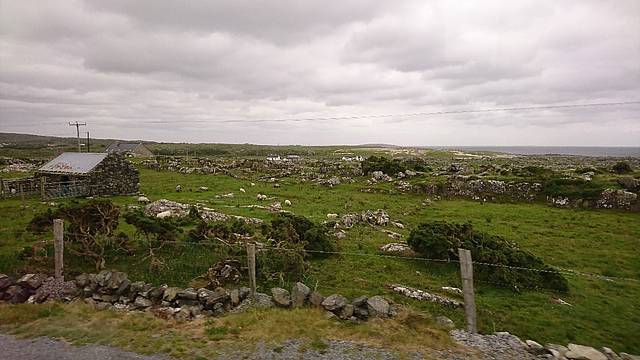
© Selina Rüb
In summer 2017, a very outstanding experience took place for future English teachers from the University of Wuerzburg and the University of Augsburg. While the seminars on how to teach English to students usually focus on theoretical aspects, we had the chance to combine the theory of planning a class trip with the actual experience abroad and the implementation of what had been planned before.
14 students from the University of Wuerzburg, together with Prof. Dr. Maria Eisenmann, and 11 students from the University of Augsburg, together with Prof. Dr. Engelbert Thaler, wanted to experience Ireland and its culture. Dr. Ina Bergmann, from the University of Wuerzburg, accompanied us as well. With her connections to the Trinity College in Dublin and the University of Galway, and her friendly and welcoming attitude, her participation on the trip was an enrichment for us all.
Before the trip, we did the planning in seminars, each university on its own. We were divided into groups with different responsibilities, and each group had a corresponding “partner group” from the other university. There was a group responsible for history, one for museums, one for culture, one for Trinity College, one for geography and one for Irish writers. The framework of the trip was already given (Dublin and Galway), but we had to fill it with life. Therefore, we did research, planned, booked and prepared the presentations for abroad. As this excursion should not only show us what to do with students in Ireland, but also how to do it, one part of our presentations was to think about the didactic implementation of the content in- and outside the classroom.
End of June we were all set for Ireland. How exciting to soon meet the students from the other university for the first time!
MONDAY: after arriving separately in Dublin, we all met at the Harcourt Hotel in Harcourt Street between 1 and 2 pm. The sooner one arrived, the more time one had for a good Irish Coffee! Good start for a good trip. As soon as everyone had arrived, we set out for our first walk around the town, led by the group responsible for history. The first stop was St Stephen’s Green, a park area quite close to our hotel at the end of Grafton Street. At each stop, there was a short presentation on the facts and stories about each destination. Just the way one could do it with students! The next stop was Dublin Castle – built in the 13th century, it nowadays holds some of the government departments. As we had a lot of stops on our agenda, we hurried on to Christ Church, also known as The Cathedral of the Holy Trinity. It is one of Dublin’s eldest medieval cathedrals, next to St Patrick’s Cathedral. Off we went from there on to the Temple Bar area with the Temple Bar itself, probably the most famous pub in Dublin, and all its other pubs around. During the day, there is not too much going on there apart from the tourists running after a few good pictures of this well-known place, but at night Temple Bar is full of people partying and trying to experience the Irish pub culture. But always keep in mind: when going there with students, it is important to think of the additional benefit such a visit of a pub could have. Quite close to the Temple Bar area, in Grafton Street, there is the statue of Molly Malone – a well-known figure in Dublin, and to foreigners also known thanks to the song by The Dubliners:
“In Dublin's fair city, where the girls are so pretty, I first set my eyes on sweet Molly Malone. As she wheeled her wheel-barrow, through streets broad and narrow, crying ‘Cockles and mussels, alive, alive, oh!’”.
It is not known whether the fictional character Molly Malone is based on the life of a real woman or not. Legend has it that Molly Malone was a fishmonger, who also worked as a part-time prostitute. It is said that she died very young of a fever. The statue is a tourist attraction and many tourists passing by grab Molly Malone’s bosom for luck, so that one can see the bronze wearing off there.
So far, we had only been on the south side of the River Liffey. It divides Dublin into two parts, but there are multiple beautiful bridges between the two parts of the city. Our next stop should have been the so-called GPO (General Post Office), headquarter of the rebels during the Easter Rising of 1916 and therefore an important site for the history of the Republic of Ireland. But the GPO lies in O’Connell Street on the north side of the town. As we had already walked a lot and were quite hungry, we decided to skip that stop and look for a nice pub instead to grab some Irish food and drink a pint of Guinness. We still had two days to go in Dublin!
TUESDAY: after a rather heavy Irish Breakfast with sausages, bacon and scrambled eggs, we set off quite early for the destination of this morning: Trinity College Dublin. Famous people once studied there, including Oscar Wilde and Samuel Beckett. First, we went to one of the modern buildings on the campus, just next to the Library with the famous Book of Kells. In the Trinity Long Room Hub Arts & Humanities Research Institute, we were welcomed by Dr. Caitriona Curtis, the Institute Manager. She explained the tasks of the institute to us:
“The Trinity Long Room Hub offers a world-class research environment that harnesses and expands the excellence of Trinity’s Arts and Humanities research by pioneering and facilitating cross-disciplinary collaborative projects."
She also showed us around the highly modern building constructed in 2010, that received many prizes for its architecture. In one of the rooms, where the researchers usually meet for presentations and conversations, we were allowed to have a presentation about the history of Trinity College and its faculties, as well as the Book of Kells. After some refreshments, we went next door to the Library with the famous Book of Kells. The Book of Kells is an old Gospel book written in Latin and probably created around 800 AD. It contains the four Gospels of the New Testament and is illustrated with many pictures. Unfortunately, one can only see one page at a time, as it is kept in a glass case. Passing through the room with the Book of Kells and up the stairs one can stroll down the Old Library – what a sight! A very high ceiling, shelves on both sides of the long room and statues of important philosophers and writers on both sides…and books, books, books! We were amazed - so many books in such a wonderful place! We saw some German pupils running around with handouts – and immediately thought of the options we would have to bring this place closer to students through different tasks. The idea of this trip was obviously working!
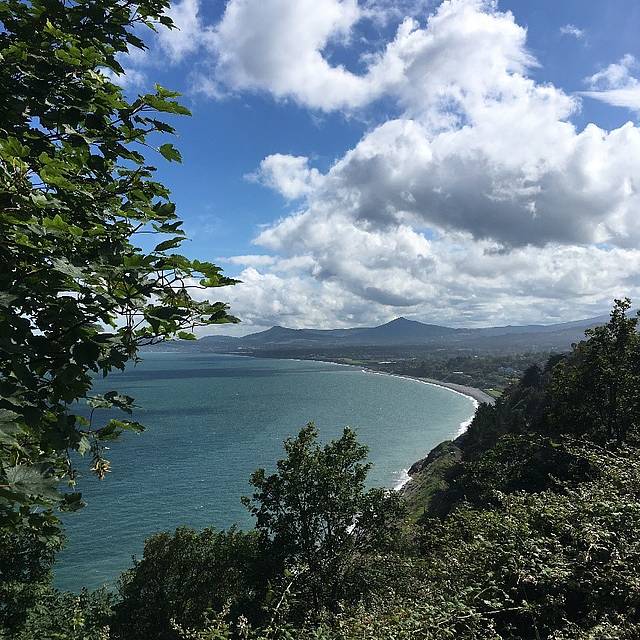
© Ina Bergmann
But once again we still had many things to do and see. After a short tour around the campus and some food and drinks, we set off to the Tara Train Station to get the train to Dalkey, which is a lovely little village half-an-hour drive away from Dublin next to the sea. After having rushed through Dublin City, it was nice to escape the hectic city life and enjoy the more rural landscape and some quiet time. And the landscape outside Dublin is outstanding! We walked through Dalkey in the direction of Killiney. There are beautiful houses on the hill, with a great view over Dublin Bay and of course the Irish Sea. It felt Mediterranean, especially because the sun was shining and therefore the wind did not seem so cold anymore. Some brave students even jumped into the cold water, celebrating the ‘Irish summer’. Up the hill we went towards Killiney Hill Park and the Killiney Obelisk. Especially in the end the path got very steep – we were happy to arrive at the top of the hill. The view was breathtaking! Just before the Killiney Obelisk, there was a ‘wishing pyramid’. Of course we didn’t miss the chance to walk up to the top in circles, while looking towards Dublin and making a wish with our eyes closed as soon as we arrived on the top. Dr. Bergmann obviously had a good time taking a video of the line of students climbing up the pyramid. It was much fun! The Killiney Obelisk was built in commemoration of the ‘forgotten famine’ of 1740/1741 due to an exceptionally cold winter. After a short rest, we continued our way down to the village of Killiney to take the train back to Dublin. We were all quite exhausted but very happy to have done this walk.
WEDNESDAY: in the morning we checked out of our hotel and once again made our way to the city. Topic of this morning: Irish writers. Originally, five stops were included in the tour: St. Patrick’s Cathedral with the Grave of Jonathan Swift, the Cú Chulainn statue in the General Post Office, the James Joyce Statue and Mulligan’s Pub, as well as the Oscar Wilde Memorial. However, for it was a very rainy day, we only managed to walk to St. Patrick’s Cathedral, where we listened to student presentations on both Saint Patrick and Jonathan Swift, whose grave is inside the cathedral. From there, across the River Liffey and down O’Connell Street, we walked to the General Post Office. Inside the GPO there is a statue of Cú Chulainn, who is a very important figure both for Irish identity as well as for William Butler Yeats. We heard a presentation about William Butler Yeats and one of his poems there. Furthermore, another presentation on the Easter Rising, that had been planned for Monday, was then given in the GPO as well and illustrated quite nicely how history is always intertwined with culture and reflected in literature and arts in general. After those stops, we walked past the James Joyce statue. However, we didn’t linger there due to the heavy rain, but went straight to the National Museum of Ireland: Archaeology and did that part of our agenda first. In the Museum, we learnt a great deal about Medieval Ireland (1150-1550) and Viking Ireland presented in a very illustrative way, which was both very enlightening and interesting. As to the literary walking tour: the two missing presentations about James Joyce and Oscar Wilde were then given in a dry spot in front of the museum and back in the warm and cosy hotel lobby.
In the afternoon, we collected our luggage at the hotel and took the bus to Heuston Station, from there we took the train to Galway. Many of us had an extended nap on the train – sightseeing during the day, much information to take in and not to forget a pint or two of Guinness every night had made everyone tired. Three hours later we got off the train in Galway and made our way to the hostel by foot. Sleepzone – the name of the hostel was very welcoming to us! Food, drinks, a bit of rest: at 7 pm half of our group met to go to a musical called Misé Éire – I am Ireland at the Black Box Theatre Galway. After a short introduction to some famous Irish tales and legends, we dived into a very special “Irish Experience”: accompanied by fiddle, harp, Irish flute and step dancers, we could emerge into the Irish history from the pre-Christian times till the Proclamation of the Republic of Ireland. From Grace O’Malley, the “Sea Queen of Connacht”, to the story of how Cú Chulainn, an Irish hero and warrior of the pre-Christian time, got his name (meaning “Hound of Chulainn”); from the story about the Claddagh Ring (a well-known symbol that stands for love, friendship and loyalty) to the Great Famine and the Emigration to the New World in the middle of the 19th century; and from there to the Easter Rising of 1916, the Proclamation of the Republic and finally, Ireland’s independence from the United Kingdom. The musical showed the pride of the Irish in their country and their culture. We all enjoyed the musical very much as it summarized many of the places and stories we had seen and heard the days before in Dublin. We decided that it would be worthwhile to go there with students as well – provided with the right tasks, they could learn much about history and culture in a very entertaining environment.
THURSDAY: It was time for nature and the coast again. We had a private coach plus driver who took us through the great scenery of the Connemara National Park. Our tour started in Galway at 10 am. Connemara is an area located on the western coast of Ireland where the Irish language is predominately spoken. The rural area has an incredible landscape to offer. We were overwhelmed by the diversity of hidden lakes, mountain ranges, wide beaches and rocky ground. First stop was Kylemore Abbey, a castle reminding us of fairy tales. It is located next to a small lake and has a beautiful Victorian walled garden. Afterwards we drove to a cute little fisher village to get lunch there. It was windy and cold outside, but this fact did not bother us anymore after a few days in Ireland! We continued our journey after an hour, as we still had quite a few kilometres to go on small and bumpy roads. On the way we got the chance to see more of the beautiful shore of the Atlantic Ocean. After a while we stopped again at a breath-taking beach to dip our feet in the water and to take more pictures. But the sky was very cloudy and from time to time it was raining, so we decided to drive back to Galway.
In the evening, before we set out for our pub crawl, we had a little practical activity outside our hostel. We danced an Irish folk dance called Bridge of Athlone. Everyone had to choose a partner and then we lined up, men facing women. And off we went! Forward, two, three, bow; back, two, three, four. Swing your partner with the right arm, swing your partner with the left arm. And now the first couple dances down the aisle! And back up again! And everyone follows, the first couple makes a bridge, and everyone passes through into their new position. And from the start! Forward, two, three, bow…after five minutes of dancing and laughing and stepping on each other’s feet from time to time everyone was exhausted, but one couldn’t see a face without a smile on it. Dancing is freeing up emotions and bringing cultures together in a unique way.
After the dance, we went to a few pubs in Galway. On the bus and back in the hostel we had heard presentations about Irish Traditional Music, also called Trad Music. As Galway is a very touristic place, one can find many pubs offering live music every night. But it was hard to find a pub with space for around thirty people, so the group soon split and everyone looked for their own pub crawl. Some of us went to a pub called O’Connor’s, where Ed Sheeran shot part of the video to his famous song Galway Girl: “She played the fiddle in an Irish band, but she fell in love with an English man…”
It was a good night out!
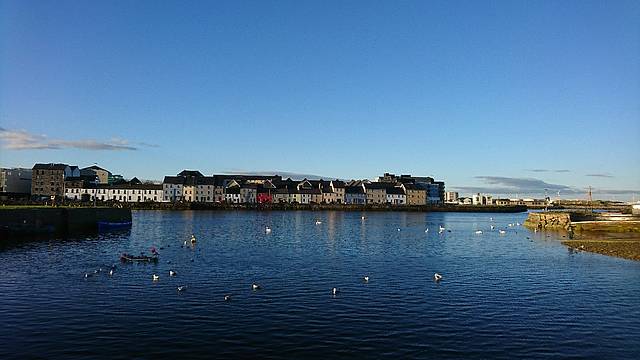
© Selina Rüb
FRIDAY: in the morning we headed out for a Galway city tour. Not only did we just walk around the beautiful town, we also grouped up and tried to answer all the questions of a rally that was especially made up for the tour around Galway. We started at Eyre Square, a small park area close to our hostel. It is also known as John F. Kennedy Memorial Park, as the president of the United States gave a speech there during a trip through Europe. Walking down the pedestrian zone with its little shops and street musicians we passed Lynch’s Castle, a medieval limestone building. It was home to the Lynch family, one of the most powerful families of the area at that time. Afterwards we stopped at St Nicholas church. Legend says that Christopher Columbus once worshipped there. Following the direction of the coast we reached the Galway City Museum, that provided us with additional information about Galway and its past. Next to the Museum one can still see the Spanish Arch, which is part of the old wall around the town and is known as a former fish market place. Passing the river Corrib we reached the Claddagh, which means “stony beach” in Gaelic. It is one of the oldest former fishing villages in Ireland and has been recorded since the arrival of Christianity in Ireland in the 5th century. During the Great Famine, many of its inhabitants left, especially the young men. Next stop: Nora Barnacle house – the place where James Joyce’s wife grew up. Unfortunately, the little museum inside was closed that day. A bit further on we walked over the Salmon Weir Bridge and came to the Galway Cathedral. Time for some lunch! An hour later we all met again at the Cathedral – those of us who had been there earlier could even watch an Irish wedding happening there! Our last stop was the National University of Ireland, Galway, where we got the chance to listen to Dr. Erin A. McCarthy as she explained her research project RECIRC: The Reception & Circulation of Early Modern Women's Writing, 1550-1700:
“RECIRC is producing a large-scale, quantitative analysis of the reception and circulation of women's writing from 1550 to 1700. The results will enable analysis of how texts, ideas and reputations gained traction in the early modern period."
Dr. McCarthy is one of ten female researchers concerned with this project.
After showing us around the mosrn campus, Dr. McCarthy led us to the oldest part of the university, the historical Quadrangle Building from 1849. The sun was shining, some students lay on the grass reading a book – the University of Galway seems like a very good place for studying!
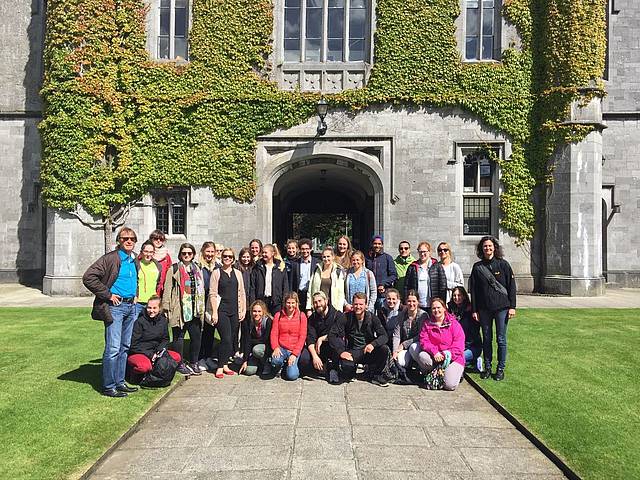
© Deborah Metzlaff
As it was our last evening, we decided to have dinner together at the famous “King’s Head” pub restaurant. Irish food and once again a pint of Guinness – a decent end for a very informative and enriching trip!
All in all, the participants in this excursion got along very well, which contributed to an utterly pleasant and learning-friendly social environment, beneficiary for everyone: thanks to the informative presentations prepared by the students and the outstanding organizational contributions by Dr. Bergmann and, most notably, Prof. Dr. Eisenmann, we learned a fair deal about life on the Emerald Isle: We became acquainted with its culture, literature, music, language, history and the geography of both its rural and urban areas. The knowledge gained in the seminar and during the excursion forms the basis of one day planning a class trip to Ireland ourselves.
In the name of the group, we would like to thank everybody who made The Irish Experience as stunning and unforgettable as it was!
Prof. Dr. Maria Eisenmann, Michelle Zirkel, Lisa Jaretzke, Deborah Klein


